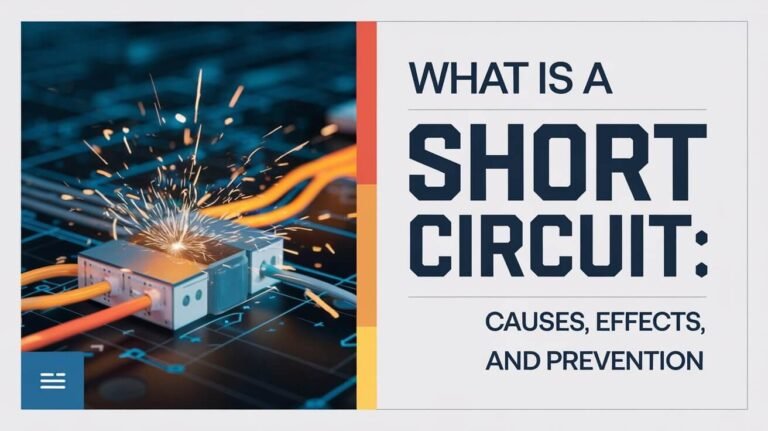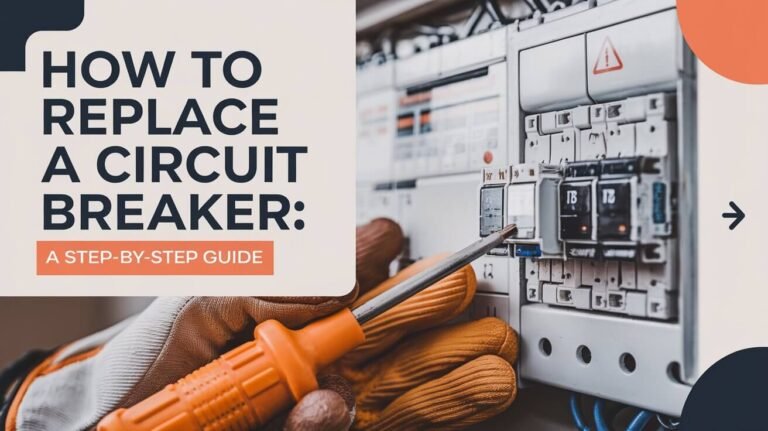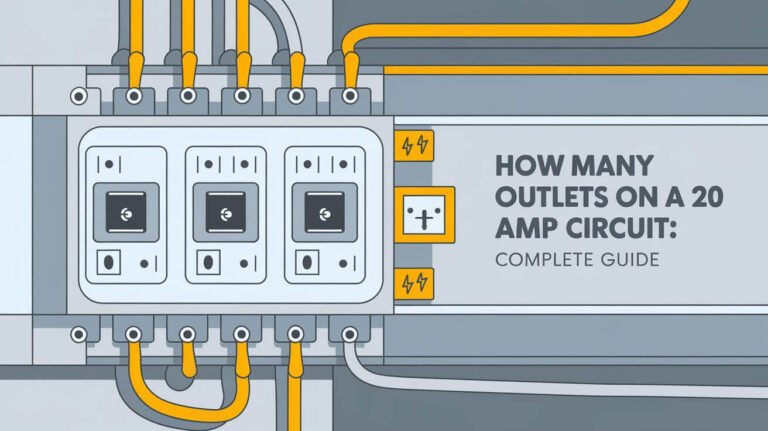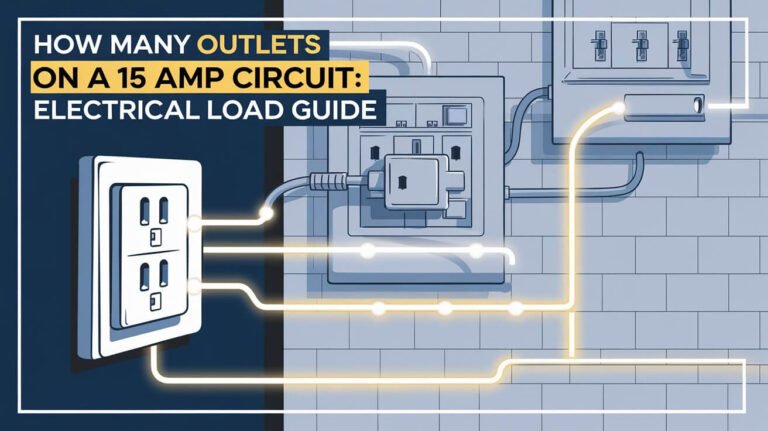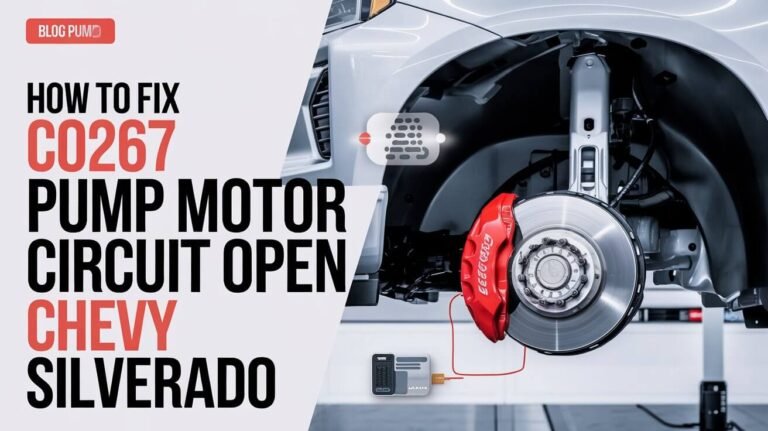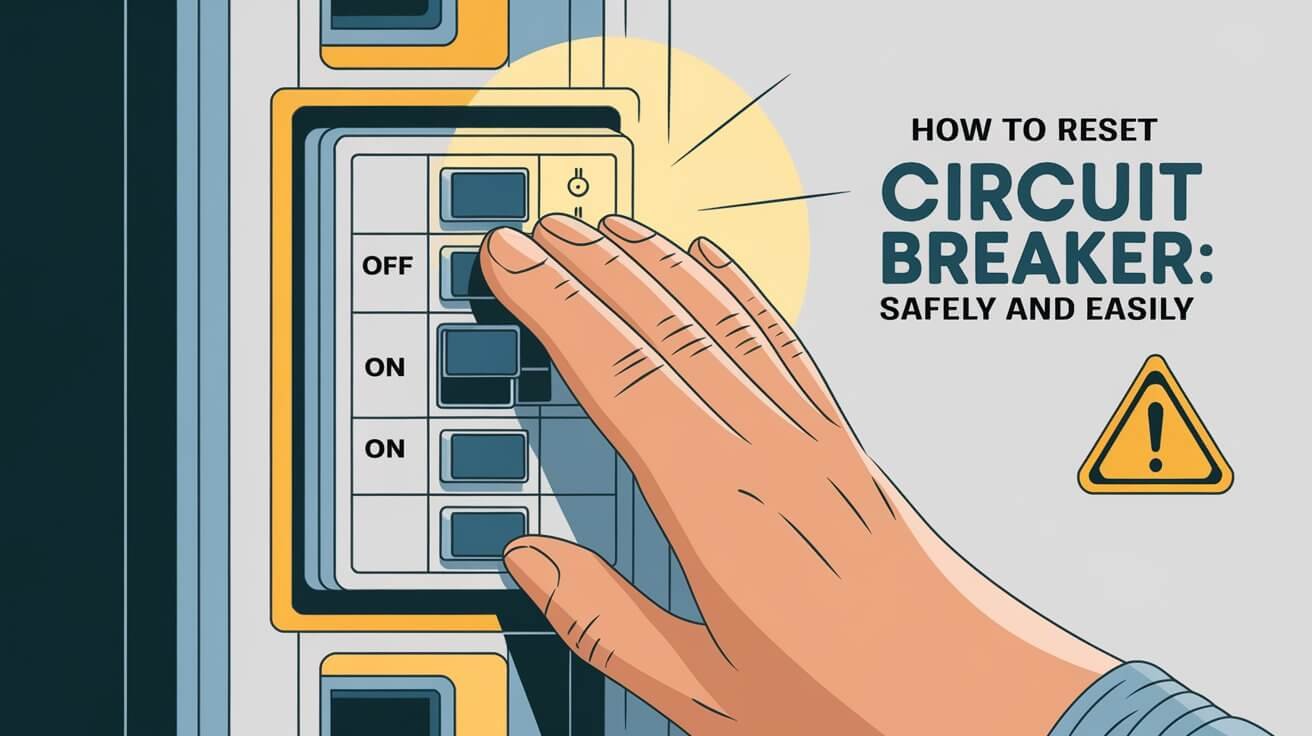
Ever found yourself in the dark, wondering why the power went out? Often, it’s a tripped circuit breaker. But resetting it is easy and can bring back power fast. We’ll show you how to do it and share safety tips to keep your electrical panel safe.
Circuit Breaker Basics and Safety Features
To keep your electrical circuit maintenance in top shape, it’s key to know the basics of circuit breakers. These systems are vital for safety. They cut off power when there’s a fault or overload, protecting your home and gadgets.
Components of a Circuit Breaker System
A circuit breaker system has a few main parts. There’s the breaker switch, electrical contacts, and a trip mechanism. The switch controls the power flow. The contacts open and close the circuit. The trip mechanism spots problems like short circuits or overloads, making the breaker trip and stop power.
Primary Safety Functions
- Prevent electrical fires by cutting off power during overloads
- Protect sensitive electronics and appliances from voltage spikes or surges
- Safeguard against electric shocks by interrupting the current flow
- Ensure the overall safety of a building’s electrical system
Types of Circuit Breakers
There are many types of circuit breakers, each for different needs and protection levels. You have standard circuit breakers, ground fault circuit interrupters (GFCIs), and arc fault circuit interrupters (AFCIs). Picking the right one is important for a safe and dependable electrical system in your place.
Common Causes of Circuit Breaker Trips
Knowing why circuit breakers trip is key to keeping our electrical systems safe and working right. We need to find out what’s causing the problem to avoid power outages and electrical dangers. Let’s look at some main reasons why circuit breakers might trip.
Circuit overload is a big reason. It happens when too much power is used on a circuit. This can be because of too many big appliances or bad connections. To fix this, we should unplug things, plug them in one by one, or get a new circuit for high-power areas.
Short circuits and ground faults are other common causes. Short circuits happen when wires touch each other or the ground. Ground faults occur when a wire touches something it shouldn’t. Both can make a circuit breaker trip. GFCIs help with ground faults, but regular breakers can handle these problems too.
| Cause | Description | Recommended Solution |
|---|---|---|
| Circuit Overload | More amperage drawn than the circuit is designed to handle, often due to too many high-wattage devices on the same circuit. | Disconnect items from the circuit, plug in items one at a time, or install a new dedicated circuit. |
| Short Circuit | A hot wire comes in contact with another hot wire, the neutral, or the ground. | Identify and fix the short circuit by a qualified electrician. |
| Ground Fault | A hot wire touches a non-current carrying part of the electrical circuit. | Use a ground-fault circuit interrupter (GFCI) to monitor for and prevent ground faults. |
Knowing why circuit breakers trip, we can stop power outages and electrical dangers. This keeps our electrical systems safe and reliable. It’s important to fix problems quickly to keep our homes and businesses running smoothly.
Essential Safety Precautions Before Reset
Before you try to reset a tripped circuit breaker, it’s key to take the right safety steps. Resetting a breaker without care can be very dangerous. So, let’s make sure we stay safe every step of the way.
Required Safety Equipment
When working with electrical systems, the right gear is crucial. Wear rubber-soled shoes to avoid standing in water or conductive areas. Also, having a flashlight ready can help us see the breaker box safely, even in dark places.
Environmental Safety Checks
Do a detailed check of the area around the breaker box. Look for water damage, exposed wiring, or other electrical dangers. Don’t touch the electric meter, as it might be live. These simple steps can help us avoid accidents and ensure a safe reset.
Locating Your Home’s Breaker Box
Finding the electrical panel in your home might seem hard, but it’s key for safety and fixing home electrical fixes. The breaker box is usually a metal box, taller than wide, found in places like near the water heater or in the garage. It can be at chest height, above your head, or below your knees. Sometimes, it’s even outside.
Once you find the breaker box, you’ll see black switches in vertical columns. These are the circuit breakers. They trip and cut off power if a circuit gets too hot or has a short circuit. Knowing how your breaker box works is the first step to safely resetting a circuit breaker or fixing electrical panel safety problems.
| Statistic | Value |
|---|---|
| Most circuit breaker panels have | two vertical rows of breakers |
| If the breaker re-trips, it could be due to | too many lamps and appliances plugged into the circuit, a damaged cord or plug, a short circuit in a receptacle, switch or fixture, or faulty wiring |
| Percentage of cases where circuit breaker requires professional electrician intervention | High due to potential short circuits or bad breakers |
| Older homes and apartments often have | one or more fuse boxes with two to eight fuses |
| Fuses are rated at | 15, 20, or 30 amps, depending on the size of the electrical wire they protect |
Knowing where your breaker box is and how it’s set up helps you deal with electrical panel safety and home electrical fixes better. If a breaker keeps tripping or you think there’s a serious electrical problem, get a professional electrician’s help.
How To Reset Circuit Breaker
Step-by-Step Reset Procedure
Resetting a tripped circuit breaker is easy and can be done in under an hour. It’s a beginner-friendly DIY project. Here’s how to do it:
- Find the breaker box in a utility room, basement, or garage.
- Look for the tripped circuit breaker. It will be in the middle, not fully on or off.
- Turn the breaker fully to the “off” position, then back to the “on” position firmly.
- If all breakers are off, start with the main breaker. Then reset each one individually.
- Make sure to operate the switches correctly to avoid damage to the electrical system.
- After resetting, test your lights and appliances to see if the power is back.
Proper Switch Operation Techniques
When resetting a circuit breaker, operate the switches correctly. Avoid flipping the breaker back and forth quickly. This can cause damage. Instead, take your time to switch it fully to the “off” position before moving it to the “on” position.
If the breaker keeps tripping after resetting, it might mean a bigger problem. This could be an overloaded circuit, short circuit, or open fault. If this happens, unplug high-wattage appliances and call a professional electrician for help.
| Potential Cause | Symptom | Next Steps |
|---|---|---|
| Overloaded circuit | Tripped breaker, often in older kitchens and bathrooms with many appliances | Unplug devices, reset breaker, watch for future trips |
| Short circuit | Tripped breaker, flickering lights, or burnt smells | Check wiring, call electrician for repairs |
| Open fault | Tripped breaker, ungrounded electrical system | Call electrician for a thorough check and repairs |
| Aging breaker | Frequent tripping, more with many electronic devices | Replace circuit breaker with an electrician’s help |
Resetting a circuit breaker right and knowing why it trips can keep your home’s electrical system safe and reliable. If the problem doesn’t go away or you’re not sure why it’s tripping, always get help from a professional electrician for circuit breaker reset procedure and electrical system repairs.
Signs of a Damaged Circuit Breaker
As homeowners, it’s important to watch over our electrical circuit breakers. A damaged or malfunctioning circuit breaker can be a serious electrical hazard prevention risk. It can also affect the electrical circuit maintenance of our homes. Here are some signs that a circuit breaker might need attention or replacement:
- Visible fraying or damage to wires, hot-to-the-touch outlets, or scorching around the electrical panel can signal a problem with the circuit breaker.
- Outlets that spark, shock, or appear melted or singed are another red flag that the circuit breaker may be failing.
- Unusual crackling or buzzing sounds emanating from the circuit breaker or electrical panel can also indicate a damaged component.
If a circuit breaker keeps tripping or won’t stay on, it’s a clear sign of a problem. Flickering lights, power fluctuations, and dimming lights can also point to a failing circuit breaker. The age of the electrical panel and circuit breakers, usually around 30-40 years, can affect their performance.
| Symptom | Potential Cause |
|---|---|
| Frequent breaker trips | Short circuit, overloaded circuit |
| Breaker won’t reset | Short circuit, faulty breaker |
| Burning smell from breaker | Overheating, electrical issue |
| Flickering lights | Failing circuit breaker |
If you see any of these signs, it’s important to get a professional electrician to check it out quickly. Trying to use a damaged circuit breaker can be dangerous. It can cause more electrical problems or even start a fire. By being careful and fixing circuit breaker issues early, we can keep our home’s electrical system safe and reliable.
Preventing Future Circuit Overloads
Keeping your home’s electrical system safe and reliable is key to avoiding circuit overloads. By using a few simple tips and strategies, you can lower the risk of electrical dangers. This ensures your home’s electrical setup can handle the load.
Power Distribution Tips
Spread out high-power appliances like ovens, washers, and dryers on different circuits. Don’t plug too many devices into one outlet or circuit, as this can cause an overload. Use power strips with circuit breakers for extra safety, where many electronics are plugged in.
Load Management Strategies
- Check your home’s power use often and find circuits that are always overloaded. This might mean you need to upgrade your electrical system or add more circuits.
- Make sure high-wattage appliances and devices aren’t all on the same circuit at once.
- Choose energy-saving options like LED bulbs and Energy Star appliances to lessen the electrical load on your circuits.
Following these electrical hazard prevention and home electrical fixes tips, you can manage your home’s power use better. This reduces the chance of future circuit overloads. It’s wise to tackle issues early to keep your home and family safe.
When Professional Help is Required
Keeping your home’s electrical system safe and working right is key. Sometimes, you’ll need a pro electrician’s help. Resetting a tripped circuit breaker is easy for many, but not always.
If a circuit breaker won’t reset, or trips often, call a pro. This could mean a bigger issue like too much load on a circuit or a short. Not fixing it can cause fires or harm your electrical system.
Other signs you need a pro include:
- Burning smells or damage to the breaker or wiring
- An old electrical panel that needs an update
- The main breaker trips, affecting power in your home
Trying hard diy electrical work without the right skills is risky. Electricians know how to handle dangers, follow codes, and keep your system safe. They can avoid more damage and keep you safe from fires or shocks.
It’s wise to be cautious with your home’s electrical system. Always choose to get help from a pro when you need it. This way, you keep your home, family, and mind at ease.
Circuit Maintenance and Inspection Guidelines
Keeping our electrical systems in good shape is key for safety and avoiding big repair costs. We suggest checking your circuit breakers by turning them off and on to see if they work right. Also, keep a record of any issues or trips. This info is very useful when you need a pro electrician.
Regular Testing Procedures
Experts say we should check high-voltage circuit breakers every 6 to 12 months. Medium-voltage ones need yearly checks or after 2,000 uses. Testing for insulation, contact, and timing helps catch problems early.
Things like temperature, humidity, and dirt can affect how well breakers work. So, it’s important to watch these factors too.
Documentation Requirements
Good records are crucial for our electrical panels and breakers. Make sure to note any changes, fixes, or new parts. Also, follow the makers’ maintenance tips. This info is super helpful during yearly checks or if problems pop up later.
Staying on top of electrical upkeep and safety is a big responsibility for homeowners.

